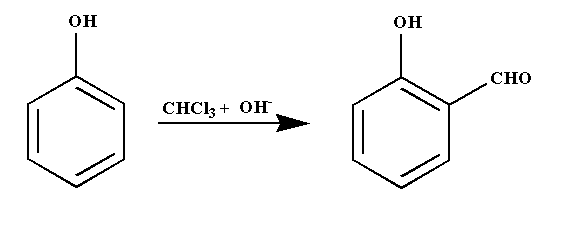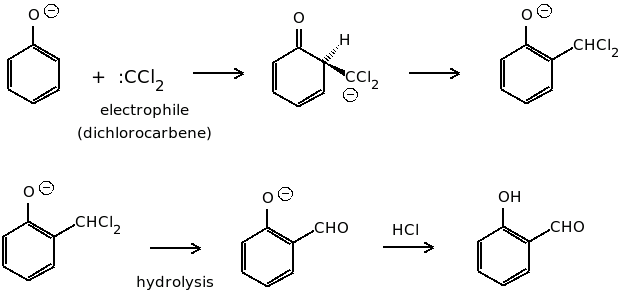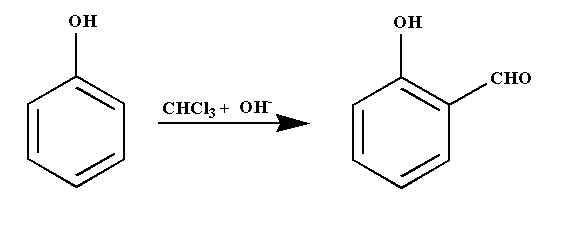
Answer
427.8k+ views
Hint: In Reimer-Tiemann reaction, first the chloroform reacts with the base and deprotonates to form chloroform carbanion which further on alpha elimination forms the reaction species which have neutral carbon atom with unshared valence electrons.
Complete step by step answer: The given reaction is an example of Reimer-Tiemann reaction. It is a type of substitution reaction. In this reaction, phenol is reacted with chloroform in the presence of base sodium hydroxide which results in the substitution of an aldehydic group on the ortho position of the benzene ring forming a compound named ortho hydroxybenzaldehyde.
The Reimer-Tiemann reaction is shown below.

In this reaction first the chloroform is deprotonated by the base to form a chloroform carbanion. The chloroform carbanion undergoes alpha elimination to form dichlorocarbene.
The reaction for the deprotonation of the chloroform is shown below.
$CHC{l_3} + NaOH \to NaCl + {H_2}O + :CC{l_2}$
In this reaction, chloroform reacts with sodium hydroxide to form sodium chloride, water and dichlorocarbene. The dichlorocarbene is the reactive species of the reaction.
The aqueous hydroxide deprotonates the phenol ring to form the phenoxide anion. The negative charge is delocalized in the benzene ring making it more nucleophilic in nature. The nucleophile then attacks the dichlorocarbene to form an intermediate dichloromethyl substituted phenol. At last on basic hydrolysis, the intermediate yield ortho hydroxybenzaldehyde.
The mechanism of the reaction is shown below.

Thus, the intermediate of the reaction is $:CC{l_2}$.
So, the correct answer is “Option A”.
Note:
Carbene is an electron deficient species, as it is electron withdrawing in nature due to the presence of two chlorine groups that’s why it is attracted by electron rich phenoxide ions.
Complete step by step answer: The given reaction is an example of Reimer-Tiemann reaction. It is a type of substitution reaction. In this reaction, phenol is reacted with chloroform in the presence of base sodium hydroxide which results in the substitution of an aldehydic group on the ortho position of the benzene ring forming a compound named ortho hydroxybenzaldehyde.
The Reimer-Tiemann reaction is shown below.

In this reaction first the chloroform is deprotonated by the base to form a chloroform carbanion. The chloroform carbanion undergoes alpha elimination to form dichlorocarbene.
The reaction for the deprotonation of the chloroform is shown below.
$CHC{l_3} + NaOH \to NaCl + {H_2}O + :CC{l_2}$
In this reaction, chloroform reacts with sodium hydroxide to form sodium chloride, water and dichlorocarbene. The dichlorocarbene is the reactive species of the reaction.
The aqueous hydroxide deprotonates the phenol ring to form the phenoxide anion. The negative charge is delocalized in the benzene ring making it more nucleophilic in nature. The nucleophile then attacks the dichlorocarbene to form an intermediate dichloromethyl substituted phenol. At last on basic hydrolysis, the intermediate yield ortho hydroxybenzaldehyde.
The mechanism of the reaction is shown below.

Thus, the intermediate of the reaction is $:CC{l_2}$.
So, the correct answer is “Option A”.
Note:
Carbene is an electron deficient species, as it is electron withdrawing in nature due to the presence of two chlorine groups that’s why it is attracted by electron rich phenoxide ions.
Recently Updated Pages
How many sigma and pi bonds are present in HCequiv class 11 chemistry CBSE

Mark and label the given geoinformation on the outline class 11 social science CBSE

When people say No pun intended what does that mea class 8 english CBSE

Name the states which share their boundary with Indias class 9 social science CBSE

Give an account of the Northern Plains of India class 9 social science CBSE

Change the following sentences into negative and interrogative class 10 english CBSE

Trending doubts
Fill the blanks with the suitable prepositions 1 The class 9 english CBSE

The Equation xxx + 2 is Satisfied when x is Equal to Class 10 Maths

In Indian rupees 1 trillion is equal to how many c class 8 maths CBSE

Which are the Top 10 Largest Countries of the World?

How do you graph the function fx 4x class 9 maths CBSE

Give 10 examples for herbs , shrubs , climbers , creepers

Difference Between Plant Cell and Animal Cell

Difference between Prokaryotic cell and Eukaryotic class 11 biology CBSE

Why is there a time difference of about 5 hours between class 10 social science CBSE




